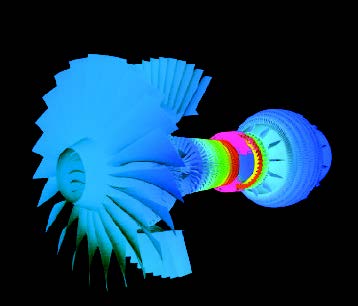Aerospace engineers such as Ohio State University professor Jen-Ping Chen, Ph.D., depend on modeling and simulations of turbomachinery, the alternating sections of spinning and fixed blades in a jet engine’s compressor and turbine, because the multiple stages and extreme temperatures make it difficult to conduct experimental measurements.
Inside a jet engine, a series of spinning and fixed blade rows called a compressor compress the air, which then moves into the combustor. The air then mixes with the fuel and is ignited, pushing hot gas out the back of the engine. A second series of spinning and fixed blade rows called a turbine extracts energy from hot gas as it flows past to keep the compressor turning and gives the airplane power. By increasing the loading, or compressing more air and pushing it through the engine, engineers get more thrust with a smaller physical size - which improves the efficiency and cost of jet engines.
Using TURBO, a computational fluid dynamics application for multistage turbomachinery, Dr. Chen simulates the airflow through multiple compressor and turbine stages. By also modeling the movement of the blade rows relative to each other, this code is capable of accurately computing the unsteady interactions between blade rows.
The Ohio Supercomputer Center is working with Dr. Chen and his research team to provide access to high performance computing resources and consulting assistance for these data-intensive simulations. He recently ran several 584-processor TURBO jobs on OSC’s IBM e1350 system during the installation testing of the new system; this gave his team unfettered access to the system for nearly two weeks.
“These multiple-blade-row simulations can be useful in investigating problems of stage matching, or aligning the air movement between the spinning and fixed blades,” said Dr. Chen. “Constraints on the flow field in a multistage machine are quite different from those in an isolated rotor. Although the flow in a single stage shows similarities with that in a multistage configuration, the finer details of airflow are sufficiently different to prevent extrapolating single-stage data to multistage configurations.”
--
OSC Partner:
The Ohio State University
Research Title:
Turbomachinery Modeling and Simulation
Funding Source:
Advanced Virtual Engine Test Cell, Inc.
Principal Investigator:
Jen-Ping Chen, Ph.D., The Ohio State University
For more information:
aerospace.eng.ohio-state.edu/people/faculty/chen/ Dr.Chen.html
